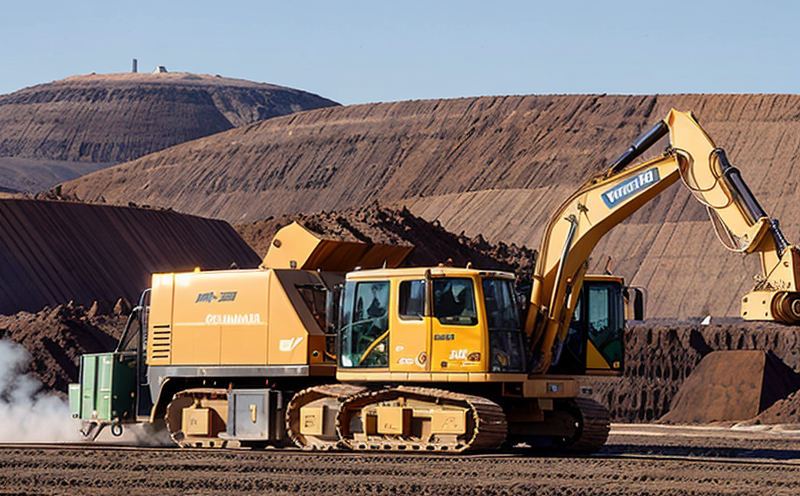ASTM D2216 Moisture Content Determination Compliance Testing in Mining
The ASTM D2216 standard is a critical tool for mining companies ensuring that materials meet specific moisture content requirements. This method provides a standardized procedure to accurately measure the water content of solid materials, which is essential for quality control and compliance with industry standards.
Moisture content can significantly impact various aspects of mining operations, including processing efficiency, storage stability, and product quality. By adhering to ASTM D2216, companies ensure that their products meet the required moisture levels as specified by relevant regulations or client specifications.
The testing procedure outlined in ASTM D2216 is designed to be robust and consistent across different laboratories and operators. This ensures reproducibility and reliability of results, which are crucial for maintaining high-quality standards within the mining industry.
Compliance with ASTM D2216 helps mining companies avoid potential issues related to product quality and regulatory non-compliance. It also enhances customer trust by ensuring that products meet the expected performance criteria.
The testing process involves several key steps, including sample preparation, drying, cooling, weighing, and calculation of moisture content based on initial and final weights. The accuracy of these measurements directly impacts the results, making precise handling and equipment calibration essential.
| Step | Description |
|---|---|
| Sample Preparation | The sample should be representative of the bulk material. It is important to ensure that no moisture adheres to the container or during handling. |
| Drying | The sample is placed in a drying oven at 103 ± 2°C until it reaches a constant weight. This temperature range ensures that water vapor can escape without affecting the material's other components. |
| Cooling | The dried sample is allowed to cool in a desiccator, ensuring that no moisture is absorbed back into the sample during cooling. |
| Weighing | The initial weight of the sample and the final weight after drying are recorded with high precision. The difference between these weights gives the mass of water lost, which is used to calculate moisture content. |
Accurate calibration of equipment such as balances and ovens is essential for obtaining reliable results. Additionally, proper sample preparation prevents errors in measurement, ensuring that the test reflects true moisture levels within the material.
The importance of ASTM D2216 compliance cannot be overstated, especially when dealing with materials used in various mining operations, including coal, ores, and aggregates. By adhering to this standard, companies can ensure consistent quality control, meet regulatory requirements, and maintain a strong reputation for product reliability.
Scope and Methodology
The scope of ASTM D2216 covers the determination of moisture content in solid materials by drying the sample at 103 ± 2°C until it reaches a constant weight. This standard is widely used across various industries, including mining, to ensure that products meet specified moisture content levels.
- Materials Tested: Coal, ores, aggregates, and other solid materials.
- Target Audience: Quality managers, compliance officers, R&D engineers, and procurement personnel.
- Industry Standards: ASTM D2216 is recognized globally for its accuracy and reliability in moisture content determination.
The methodology involves drying the sample at a specified temperature to remove all volatile components, primarily water. This process ensures that any moisture present is accurately measured and reported as part of the final results.
Calibration of equipment is crucial before conducting ASTM D2216 tests. Balances used for weighing must be precise and regularly checked against certified standards. Ovens should maintain a consistent temperature within ±2°C to ensure accurate drying times.
Environmental factors such as humidity can affect the results, making it important to conduct tests in controlled environments where variables like temperature and air flow are minimized.
Environmental and Sustainability Contributions
Compliance with ASTM D2216 not only ensures product quality but also plays a role in environmental sustainability. By maintaining precise moisture content levels, mining companies can reduce waste and improve efficiency throughout the production process.
For instance, accurate moisture measurement helps optimize processing conditions, reducing energy consumption during drying stages. This leads to lower operational costs while minimizing the carbon footprint associated with energy use.
In addition, adhering to ASTM D2216 standards supports sustainable practices by ensuring that products meet specified quality criteria without unnecessary adjustments or rework. This reduces material wastage and promotes resource efficiency within mining operations.
Furthermore, compliance with global regulations and industry standards like ASTM D2216 contributes to environmental protection efforts by fostering transparency and accountability in supply chains. This enhances trust among stakeholders, including customers, regulators, and the broader community.
The use of standardized testing methods also facilitates better communication between different parties involved in mining operations, ensuring that all participants understand expected outcomes and quality standards.
Use Cases and Application Examples
- Coal Processing: Ensuring consistent moisture levels in coal samples is crucial for efficient processing. Variations in moisture content can lead to inconsistent heat outputs, affecting the overall efficiency of power plants.
- Ore Grading: Accurate measurement of moisture content helps in grading ores based on their elemental composition and purity. This ensures that only high-quality materials are processed further, improving product value.
- Agronomic Testing: While primarily aimed at solid materials, ASTM D2216 can also be used for testing soil samples or other agricultural products in mining contexts where such materials are involved.
In each of these scenarios, compliance with ASTM D2216 ensures that the moisture content is accurately measured and reported. This consistency allows for better decision-making processes throughout the supply chain, ultimately leading to higher-quality end products.
For coal processing plants, maintaining consistent moisture levels can significantly improve boiler efficiency, thereby reducing fuel consumption and associated emissions. In ore grading applications, accurate moisture measurement aids in optimizing extraction methods and enhancing overall profitability by ensuring only high-grade ores are processed further.





